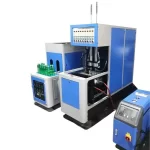The temperature of an automatic blow molding machine plays a critical role in the production process. It determines the quality, strength, and consistency of the final product. However, if the temperature is too high, it can lead to various issues that can compromise the efficiency and performance of the machine. In this article, we will explore the potential problems that can arise when the temperature of an automatic blow molding machine exceeds the recommended levels.
1. Reduced Product Quality
One of the primary consequences of excessive temperature in an automatic blow molding machine is reduced product quality. When the temperature is too high, the plastic material used for molding may become overheated and lose its desired properties. This can result in defects such as warping, shrinkage, or uneven thickness in the final product. The excessive heat can also lead to the formation of air bubbles or voids within the plastic, further compromising its integrity.
Moreover, the high temperature can cause the plastic to melt too quickly, resulting in poor control over the shape and texture of the molded product. This can lead to inconsistencies in the finished items, affecting their aesthetics and functionality. The manufacturers must ensure that the temperature is kept within the recommended range to maintain the desired quality standards.
2. Increased Energy Consumption
Another significant issue caused by high temperatures in an automatic blow molding machine is increased energy consumption. When the temperature exceeds the optimal level, the machine’s heating elements have to work harder to maintain the desired temperature throughout the production process. This leads to higher energy consumption and subsequently increased operating costs for the manufacturer.
Additionally, the excess heat generated by the machine can also affect the overall working environment, leading to discomfort for the operators. This may necessitate the use of additional cooling systems or insulation measures to maintain a suitable working temperature. The energy required to power these additional systems further contributes to the increased energy consumption and costs.
3. Equipment Wear and Tear
High temperatures can accelerate the wear and tear of the components within an automatic blow molding machine. The excessive heat places additional stress on the heating elements, control systems, and mechanical parts of the machine. Over time, this can lead to premature degradation, reduced lifespan, and increased maintenance requirements.
The heat generated by the machine can also cause thermal expansion and contraction, leading to structural deformations and misalignments. This can result in decreased precision and accuracy during the molding process. The constant exposure to high temperatures can weaken the machine’s integrity, causing it to become more susceptible to breakdowns and malfunctions.
The temperature of an automatic blow molding machine is a critical factor that must be carefully controlled to ensure optimal production outcomes. While it is essential to maintain a suitable temperature range for efficient operation, it is equally important to avoid surpassing the upper limit. Excessive temperatures can lead to reduced product quality, increased energy consumption, and accelerated equipment wear and tear. Manufacturers should regularly monitor and maintain the temperature parameters of their blow molding machines to ensure consistent and reliable performance.
.webp)
